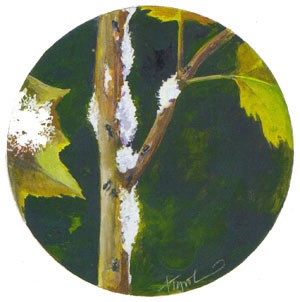
On warm days in September and October, puzzling specks of wool are sometimes seen sailing along on the breeze. Some of these fuzzballs might be woolly alder aphids, insects that have been sitting tight and sucking sap on alder all summer but which now are migrating to their winter homes, usually on silver maple. More than half of each speck is made up of a waxy, curly, white wool, excreted from the insect’s abdomen. These entangling filaments help keep the little creatures from being eaten. Many other aphid species don’t have this wool and they defend themselves with repulsive chemicals emitted from tiny spines on their backs.
Aphids are all too familiar to most people: typically, all it takes is ownership of one houseplant to make their acquaintance. The key to aphid success lies in their reproductive potential. During the easy days of summer, most aphids reproduce parthenogenetically – a virgin female gives birth to a daughter and in no time the mom has grandchildren – again without having wasted precious time finding a mate. The young are born live, bypassing the egg stage, which also saves time and contributes to the rapid buildup of the population. In addition, all summer long, aphids are born without wings. If there is plenty of food right here at home, resources invested in wings don’t pay off. In summer, aphids focus on one thing: making more aphids.
Someone familiar with aphid reproduction calculated that, in the absence of enemies, and given plenty of food and good weather, a single female could give rise to over 600 billion offspring in a single season. And, although aphids do commonly number in the range of a million per acre, predators, pathogens, and parasites fortunately abound, and not every photosynthesizing surface is in danger of being covered with their plump bodies.
They are plump because, after they pierce plant tissues with their mouthparts, they continuously suck up sap. Sap tends to be rich in sugars but relatively poor in nitrogen, the element they need to build proteins with which to construct those new aphids. Sugars provide the fuel for the daily lives of the adult stage of insects; it’s only when making a new insect that significant protein is needed. To acquire enough nitrogen, aphids have to take in much more sugar than they need, so they excrete this extra sugar in what’s politely called “honeydew,” a food that’s highly desired by ants. Ants pay for aphid excrement by protecting the aphids from predators, and they aggressively pick off most interlopers. For the most part, it works out well for both parties.
Whenever resources are abundant, however, someone finds a way to exploit the situation, a fact just as true in an ant-tended, woolly aphid colony as on Wall Street. The strategies of two of the insects that successfully prey on woolly alder aphids have been closely examined. In the 1970s, Thomas Eisner and others found that the larva of one species of green lacewing, Chrysopa slossonae, disguises itself by plucking bits of wool from the aphids and applying the wool to its own back. The ant shepherds seem not to notice the lacewings as the lacewings pick off and eat aphids. But when Eisner removed the “sheep’s clothing,” the lacewings were seized by the ants and removed from the colony.
Another aphid predator, the caterpillar of a butterfly called the harvester, also clothes itself in wool. A competing theory about the predators’ camouflage has been proposed more recently by two different groups of scientists who analyzed the chemicals in the cuticles of the lacewing and the harvester. These researchers found that both of these predators have cuticular chemistry that, at least to some extent, mimics that of the aphids, and they believe that it is this chemical camouflage, not the physical camouflage of a woolly coat, that misleads some of the tending ant species. In any event, the aphid predators nestle in with the aphids and gobble them up. The harvester (Feneseca tarquinius) is the only North American butterfly that is almost exclusively carnivorous; the beautiful adults eat aphid honeydew, among other unappetizing fare.
Meanwhile, in late summer, in response to hormones that are in turn influenced by such things as day length, crowding, temperature, or food quality, winged aphid offspring are produced. Most woolly aphids overwinter on silver maple, though some may stick with alder. Moving to an alternate host involves a perilous journey, but it may be a way to avoid predators or perhaps to find higher quality sap come springtime. The occasional mating allows for genetic diversity, which might be needed someday to foil the disguises of some next evolving predator.


Discussion *